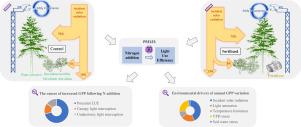Agricultural and Forest Meteorology ( IF 6.2 ) Pub Date : 2021-02-06 , DOI: 10.1016/j.agrformet.2021.108337 Xianglin Tian , Francesco Minunno , Pauliina Schiestl-Aalto , Jinshu Chi , Peng Zhao , Matthias Peichl , John Marshall , Torgny Näsholm , Hyungwoo Lim , Mikko Peltoniemi , Sune Linder , Annikki Mäkelä

|
Adding nitrogen to boreal forest ecosystems commonly increases gross primary production (GPP). The effect of nitrogen addition on ecosystem GPP is convoluted due to the impacts of and interactions among leaf scale photosynthetic productivity, canopy structure, site fertility, and environmental constraints. We used a unique controlled nitrogen fertilisation experiment combined with eddy covariance measurements and the calibration of a LUE-based (light use efficiency) photosynthetic production model in order to reveal differences in photosynthetic capacity due to nitrogen addition.A systematically designed soil moisture survey was conducted to characterise the within-site spatial heterogeneity and validate the difference of water stress between fertilised and control sites. The canopy photosynthetic light responses and environmental constraints were evaluated using an inverse modelling approach. We found that nitrogen fertilisation elevated ecosystem GPP by 24% according to model simulations. This was caused by increases in ecosystem light interception (through an increase in leaf area index (LAI)) and LUE by 7% and 17%, respectively. Nitrogen addition increased canopy potential LUE for both low and high photosynthetic photon flux density (PPFD) conditions. The calculations of leaf area and light interception indicated that the understorey vegetation contributed 9% of ecosystem GPP in the fertilised site and 7% in the control site when assuming a same LUE for trees and shrubs. The constraint arising from atmospheric water demand, rather than soil water stress, was the dominating control of the intra- and inter-annual GPP variations. The uncertainty propagated from soil moisture data is negligible for GPP predictions, but influential in the inference on the severity of the drought. This study demonstrates the combination of the controlled field experiment with the inverse modelling approach provides a powerful tool to quantitatively describe and disaggregate N addition effects on forest ecosystem GPP.
中文翻译:

分解氮素添加量对北方苏格兰松树林的初级总产值的影响
向北方森林生态系统添加氮通常会增加初级总产值(GPP)。由于叶尺度光合生产力,冠层结构,站点肥力和环境限制的影响和相互作用,氮对生态系统GPP的影响令人费解。为了揭示由于添加氮引起的光合能力差异,我们使用了独特的受控氮肥试验结合涡流协方差测量和基于LUE的(光利用效率)光合生产模型的校准,以揭示由于氮添加引起的光合能力差异。表征站点内空间异质性,并验证施肥站点和控制站点之间水分胁迫的差异。使用逆建模方法评估了冠层的光合光响应和环境限制。根据模型模拟,我们发现氮肥可将生态系统GPP提高24%。这是由于生态系统光拦截(通过增加叶面积指数(LAI))和LUE分别增加7%和17%引起的。在低光合作用和高光合作用的光子通量密度(PPFD)条件下,添加氮都会增加冠层电位LUE。叶面积和光截留的计算表明,当假定树木和灌木的LUE相同时,下层植被在施肥地点贡献了9%的生态系统GPP,在对照地点贡献了7%的生态系统。由大气需求而不是土壤水分胁迫引起的制约,是年度内和年度间GPP变化的主要控制方式。从土壤水分数据传播的不确定性对于GPP预测可以忽略不计,但对干旱严重程度的推断有影响。这项研究表明,将控制场实验与逆建模方法相结合,为定量描述和分解对森林生态系统GPP的氮添加效应提供了强大的工具。



























 京公网安备 11010802027423号
京公网安备 11010802027423号